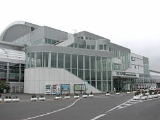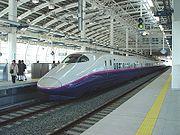
Hachinohe Station
Encyclopedia

East Japan Railway Company
is the largest passenger railway company in the world and one of the seven Japan Railways Group companies. The company name is officially abbreviated as JR East in English, and as in Japanese. The company's headquarters are in Yoyogi, Shibuya, Tokyo....
(JR East) in Hachinohe, Aomori
Hachinohe, Aomori
- Neighbouring municipalities :Aomori Prefecture*Sannohe District**Hashikami**Gonohe**Nanbu*Kamikita District**OiraseIwate Prefecture*Karumai-History:...
, Japan.
Lines
Hachinohe Station is served by the high-speed Tōhoku ShinkansenTohoku Shinkansen
The is a Japanese high-speed Shinkansen rail line, connecting Tokyo with Aomori in Aomori Prefecture for a total length of 674 km, Japan's longest Shinkansen line. It runs through the more sparsely populated Tōhoku region of Japan's main island Honshu. It has two spur lines, Yamagata...
line between Tokyo and , and forms the starting point of the Hachinohe Line to . Local services are operated by the third sector Aoimori Railway on the section of the former JR Tōhoku Main Line between and .
Station layout
Hachinohe is an elevated station with one side platformSide platform
A Side platform is a platform positioned to the side of a pair of tracks at a railway station, a tram stop or a transitway. A pair of side platforms are often provided on a dual track line with a single side platform being sufficient for a single track line...
and two island platform
Island platform
An island platform is a station layout arrangement where a single platform is positioned between two tracks within a railway station, tram stop or transitway interchange...
s serving five tracks for regular services, and two island platforms serving four tracks for Tōhoku Shinkansen services.
Platforms
| 1 | ■Hachinohe Line | tyle="border-top:solid 1px gray; border-bottom:solid 1px gray;" width=300|For , , , and |
| 2 | ■Hachinohe Line | tyle="border-bottom:solid 1px gray;" width=300|For , , , and |
| ■Aoimori Line | For , , and | |
| For , , and | ||
| 3-5 | ■Aoimori Line | For , , and |
| 11 & 12 | ■Tōhoku Shinkansen Tohoku Shinkansen The is a Japanese high-speed Shinkansen rail line, connecting Tokyo with Aomori in Aomori Prefecture for a total length of 674 km, Japan's longest Shinkansen line. It runs through the more sparsely populated Tōhoku region of Japan's main island Honshu. It has two spur lines, Yamagata... |
tyle="border-bottom:solid 1px gray;" width=300|For , and |
| 13 & 14 | ■Tōhoku Shinkansen Tohoku Shinkansen The is a Japanese high-speed Shinkansen rail line, connecting Tokyo with Aomori in Aomori Prefecture for a total length of 674 km, Japan's longest Shinkansen line. It runs through the more sparsely populated Tōhoku region of Japan's main island Honshu. It has two spur lines, Yamagata... |
For |
History
Hachinohe Station began operation as on the Nippon RailwayNippon Railway
was the first private railway company in the history of Japan. The company built trunk lines connecting Tokyo with the Tōhoku region to the northeast...
on September 1, 1891. Initially, construction of a railroad close to the coast was opposed by the Imperial Japanese Army
Imperial Japanese Army
-Foundation:During the Meiji Restoration, the military forces loyal to the Emperor were samurai drawn primarily from the loyalist feudal domains of Satsuma and Chōshū...
for defensive purposes, so the station was constructed at a considerable distance inland from the town center. The Hachinohe Line began operations on January 4, 1894 from Hachinohe Station. The Nippon Railway was nationalized
Nationalization
Nationalisation, also spelled nationalization, is the process of taking an industry or assets into government ownership by a national government or state. Nationalization usually refers to private assets, but may also mean assets owned by lower levels of government, such as municipalities, being...
on November 1, 1906, and Shiriuchi Station became a station on the Japanese Government Railways
Japanese Government Railways
The Japanese Government Railways was the national railway system directly operated by the central government of Japan until 1949. It is a predecessor of Japanese National Railways and the Japan Railways Group.- Name :...
(JGR), which became the Japan National Railways (JNR) after World War II. From 1929-1969, the now-defunct Nanbu Railways also had its terminus at Shiriuchi Station. On April 1, 1971, Shiriuchi Station changed its name to Hachinohe Station. The station previously named Hachinohe Station was renamed Hon-Hachinohe Station. Freight operations were transfer to the Hachinohe Freight Terminal later that year, and were discontinued completely from 1986. With the privatization
Privatization
Privatization is the incidence or process of transferring ownership of a business, enterprise, agency or public service from the public sector to the private sector or to private non-profit organizations...
of the JNR on April 1, 1987, the station came under the operational control of JR East. A new station building was opened on July 1, 2002, and Tōhoku Shinkansen services began operation from December 12, 2002, with operations of the Tōhoku Main Line from Hachinohe to the border of Iwate Prefecture
Iwate Prefecture
is the second largest prefecture of Japan after Hokkaido. It is located in the Tōhoku region of Honshū island and contains the island's easternmost point. The capital is Morioka. Iwate has the lowest population density of any prefecture outside Hokkaido...
transferred to the new Aoimori Railway. Following the opening of the Tōhoku Shinkansen extension to Shin-Aomori on December 4, 2010, all Tōhoku Main Line local services through the station were transferred to the Aoimori Railway.
Surrounding area
- Hachinohe Station building "Umineko plaza"
- Hotel Mets Hachinohe
- Hachinohe area stockbroker Sangho Shinko center "Yutori"
- Hachinohe-Ekimae post office
- Hachinohe Red Cross hospital
Connecting bus routes
- JR Bus TōhokuJR Bus Tohoku Companyis an operator of inter-city and regional bus lines based in the Tōhoku region of Japan. A subsidiary of the East Japan Railway Company group, JR Bus Tohoku is one of eight JR Bus companies within Japan Railways Group ....
- For Lake Towada
- Nanbu Bus
- For Gonohe
- For Konakano Bus Center via Yōka-machi
- Towada Kanko Bus
- For Towada via Shimoda and Rokunohe
- For Mikka-machi
- Hachonohe City Bus
- For Asahigaoka Bus office via Mikka-machi

